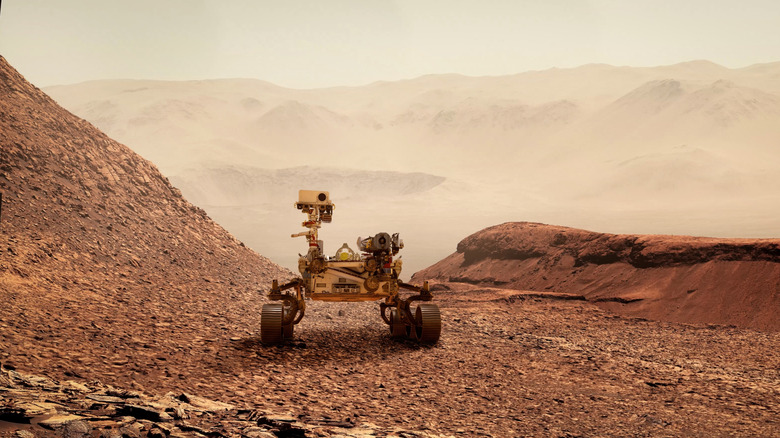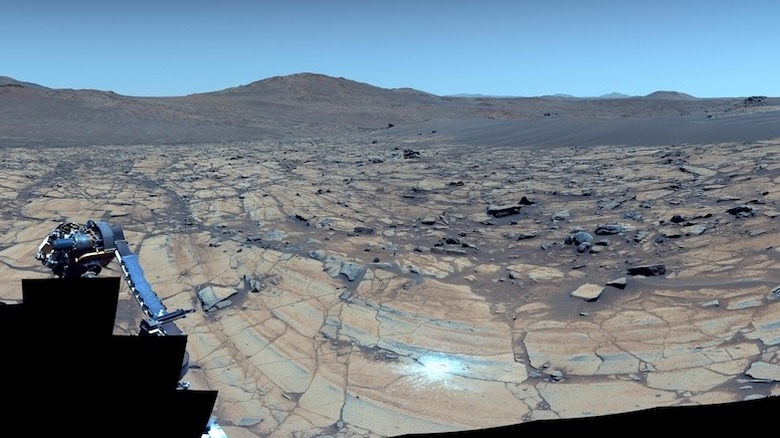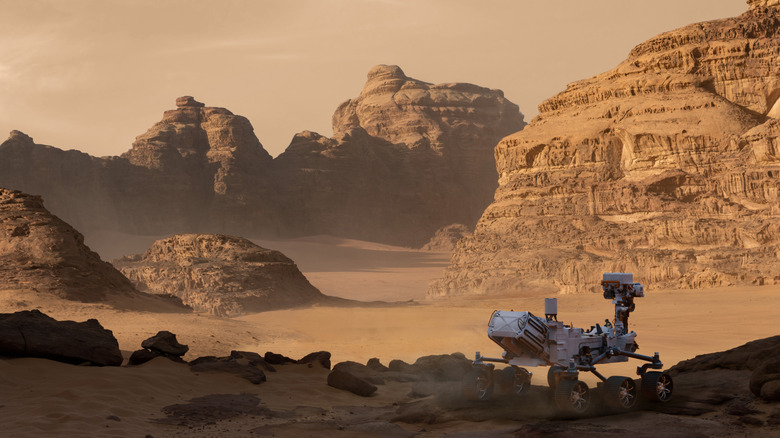NASA's Perseverance Rover Just Took The Clearest Panoramic Photo Of Mars Yet
Starting your day with one of the best-looking panoramic images of Mars is a pleasant reminder that we humans can do pretty incredible things. This inspiring photography is brought to us by NASA's Perseverance rover, operating from a location on the Red Planet's surface referred to as "Falbreen." Perseverance's imaging team was able to stitch together 96 photos captured on May 26, 2025 using the machine's Mastcam-Z instrument, taking advantage of particularly clear skies to deliver the phenomenal-looking mosaic.
But beyond the stunning vistas, scientists are just as elated by some of the geologic features Perseverance was able to home in on, including a number of sand ripples, mountainous terrain about 40 miles away from Falbreen, as well as a large rock perched atop a dark, crescent-shaped sand formation. The latter is only about 14 feet away from the rover, and scientists are referring to the boulder as a "float rock," because they believe the rock likely formed somewhere else, and was transported to its current location by wind, water, a landslide, or other means.
Speaking about the composited photo, Jim Bell, Mastcam-Z's principal investigator based at Arizona State University in Tempe, said in a press release, "The relatively dust-free skies provide a clear view of the surrounding terrain [...] And in this particular mosaic, we have enhanced the color contrast, which accentuates the difference in the terrain and sky."
Perseverance's mission and the hunt for ancient life
Launched on July 30, 2020, NASA's Perseverance Rover finally made landfall on Mars' Jezero Crater on February 18, 2021, after over seven months of space travel. The Mars 2020 mission is a big one for NASA, as it represents a major effort to answer a much-asked question: Was there ever life on Mars? Beyond its photographic capabilities, Perseverance is also equipped with a handful of geological instruments that allow the rover to collect rock and soil samples, in the hopes that, one day, Earth-bound scientists will be able to analyze these geologic samples for signs of ancient microbial life.
In both the color-graded and non-edited versions of the Mastcam-Z's panorama, you'll notice a small white mark a few inches from center-left: This is what's known as an abrasion patch, a small (the patch we're referencing is no more than two inches wide), intentionally disturbed area created by Perseverance's drill. By chipping away at some of Mars' surface, the rover is able to send back geologic data, which scientists are able to analyze to determine if they'd like to drill deeper for a core sample, which would then sealed away in one of Perseverance's titanium sample tubes.
To date, Perseverance has created 43 abrasions across Mars, and NASA is particularly keen on grabbing samples from Falbreen, because researchers believe it could be some of the oldest terrain the rover has ever explored; perhaps even older than Jezero Crater, which scientists hypothesize is billions of years old, formed during Mars' Noachian period, when the planet was potentially home to river systems and other water features.
From panorama to pathfinding
Beyond the awe-inspiring views of a distant planet, Perseverance's panoramic image helps scientists to chart the next steps of the rover's journey. The float rock discovery may even serve as a clue, providing NASA with a more precise timeline of the types of geological forces that have transformed Mars, including large-scale erosion over billions of years.
Comparing an analysis of the boulder to analyses captured of the local Falbreen terrain could help create a clearer roadmap of the float rock's journey. In doing so, scientists may even be able to load Perseverance up with coordinates for its next Martian sites, inspired by the origin point and final destination of the float rock discovered at Falbreen.
While discussing the image, acting NASA administrator, Sean Duffy, delivered an inspiring reminder that the agency wants humans exploring these Martian landscapes one footfall at a time. "Stunning vistas like that of Falbreen [...] are just a glimpse of what we'll soon witness with our own eyes. NASA's groundbreaking missions, starting with Artemis, will propel our unstoppable journey to take human space exploration to the Martian surface."


